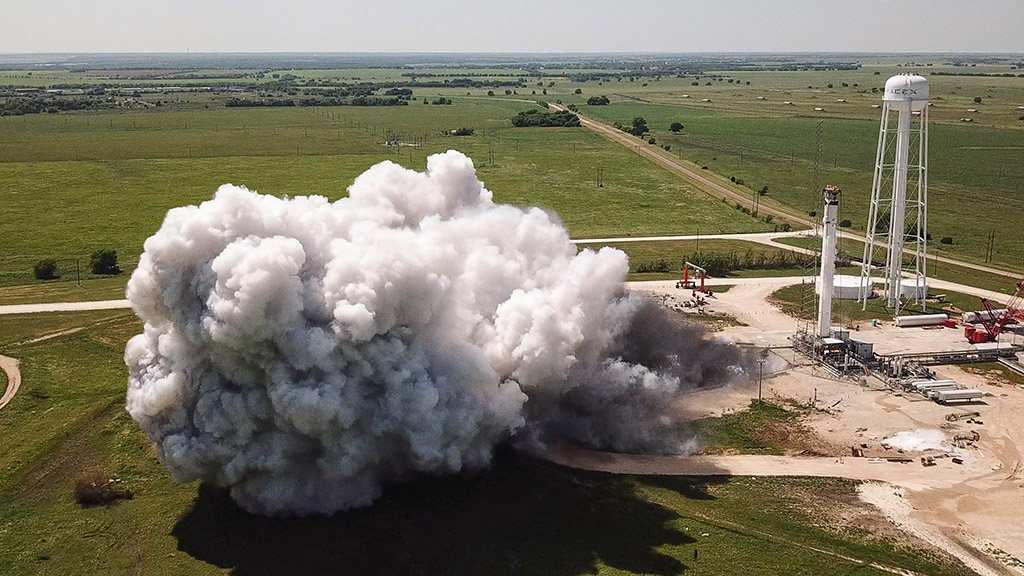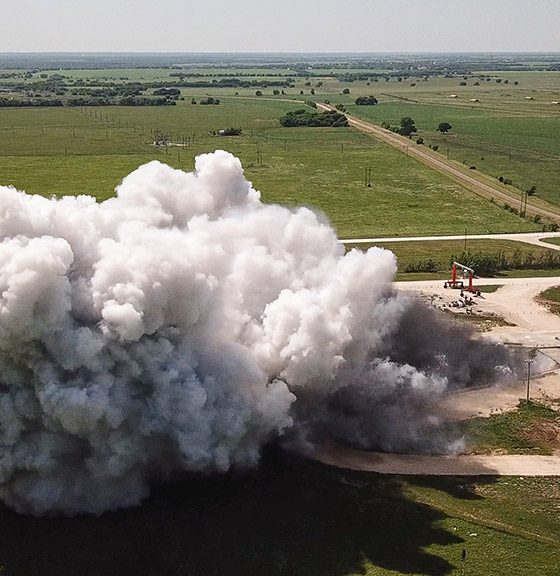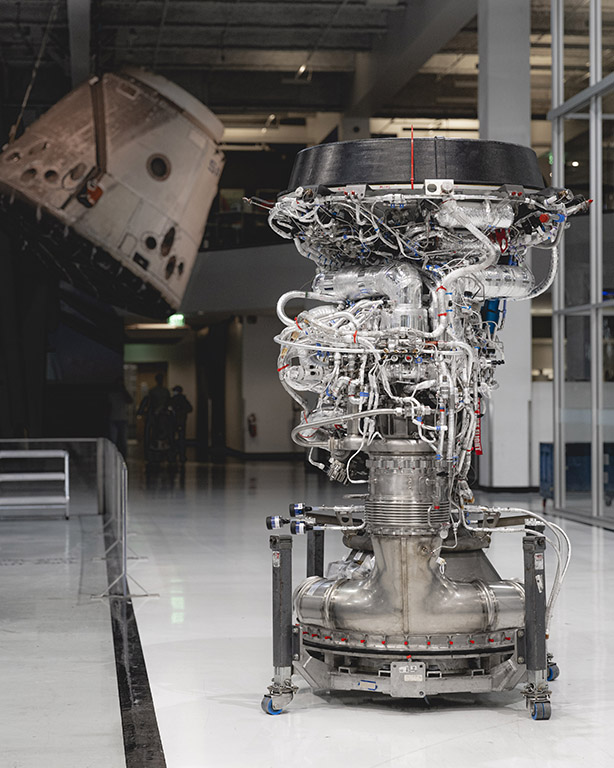

Space
SpaceX is already preparing for operational astronaut missions
While the world’s attention is focused on the return of orbital human spaceflight from US soil after a nearly decade long absence with the upcoming May 27th Crew Dragon Demo-2 mission, SpaceX is simultaneously preparing for the first Crew Dragon operational mission certified by NASA, dubbed Crew-1, slated to occur later this year.
On Friday, April 24th, SpaceX treated its Twitter followers to some rare imagery of static fire testing completed at the company’s development facility in McGregor, Texas. The company spotlighted a fresh-from-the-factory Falcon 9 booster and Falcon 9 second stage Merlin Vaccum (MVac) engine intended for the Crew-1 mission. Crew-1, the follow-up mission to May’s Demo-2 mission and SpaceX’s first operational human spaceflight mission for NASA, will propel a crew of three NASA astronauts and one JAXA astronaut in a Crew Dragon capsule to the International Space Station.
SpaceX also provided its followers with a view of the pristine second stage MVac engine of the Crew-1 mission before it was sent to Texas for testing. The one-hundredth production MVac engine is seen inside of SpaceX’s manufacturing facility located in Hawthorne, CA before being prepared for shipment. The second stage MVac engine is the only piece of Falcon 9 hardware that SpaceX does not actively recover and reuse, unlike the first-stage booster and protective payload fairing nosecone.

Part of the process
A static fire test is a typical occurrence before shipping the booster and second stage to Florida for payload integration and launch. The static fire process involves holding down the booster and igniting the engines to run for a full-duration firing. A similar test is also performed on with the second stage MVac engine. These test-fires are performed at the Mcgregor facility to proof the vehicle and check for any inconsistencies or off-nominal test readings that may occur before shipping to the vehicle to the launch site. Following the test-fire, the entire vehicle is inspected, cleaned, and prepared for shipment.
A test-fire in Mcgregor is not the last time the engines will be put through the paces before launch. Typically a week or so before the scheduled launch date, the Falcon 9 booster is transported to the launch pad. There, the booster is fully fueled with propellant while securely held to the launch mount. All nine Merlin-1D engines are once again ignited briefly (anywhere between 6 – 12 seconds) to test the propellant load process and collect engine-firing measurements such as temperature and pressure.
Certification before operation
Although the Crew-1 mission is tentatively on the books for later this year, SpaceX and the Crew Dragon capsule have yet to achieve NASA certification to begin operational missions to and from the International Space Station. The second orbital demonstration flight of the Crew Dragon capsule (Demo-2) will serve as the final end-to-end test of SpaceX’s crew transportation system.
However, SpaceX still faces a few obstacles before achieving a full go-ahead by NASA for the launch of Demo-2. As reported by SpaceNews.com NASA’s Aerospace Safety Advisory Panel (ASAP) met via teleconference on Thursday, April 23rd for a routine quarterly briefing. In that meeting, it was briefly discussed that there are still a few “technical items” that remain to be cleared by NASA before the launch of the Demo-2 mission.
Although not specified in the briefing – and likely to be followed up on during “part 2” of the ASAP meeting to be held in early May – those items likely refer to wrapping up the joint investigation of a recent in-flight engine failure of a Falcon 9 Merlin-1D engine and one more qualifying drop-test of the Crew Dragon Mark 3 parachutes. SpaceX, however, shows no plans letting formalities stop the preparation to support future astronaut missions.
Check out Teslarati’s newsletters for prompt updates, on-the-ground perspectives, and unique glimpses of SpaceX’s rocket launch and recovery processes.

News
SpaceX shades airline for seeking contract with Amazon’s Starlink rival

SpaceX employees, including its CEO Elon Musk, shaded American Airlines on social media this past weekend due to the company’s reported talks with Amazon’s Starlink rival, Leo.
Starlink has been adopted by several airlines, including United Airlines, Qatar Airways, Hawaiian Airlines, WestJet, Air France, airBaltic, and others. It has gained notoriety as an extremely solid, dependable, and reliable option for airline travel, as traditional options frequently cause users to lose connection to the internet.
Many airlines have made the switch, while others continue to mull the options available to them. American Airlines is one of them.
A report from Bloomberg indicates the airline is thinking of going with a Starlink rival owned by Amazon, called Leo. It was previously referred to as Project Kuiper.
American CEO Robert Isom said (via Bloomberg):
“While there’s Starlink, there are other low-Earth-orbit satellite opportunities that we can look at. We’re making sure that American is going to have what our customers need.”
Isom also said American has been in touch with Amazon about installing Leo on its aircraft, but he would not reveal the status of any discussions with the company.
The report caught the attention of Michael Nicolls, the Vice President of Starlink Engineering at SpaceX, who said:
“Only fly on airlines with good connectivity… and only one source of good connectivity at the moment…”
CEO Elon Musk replied to Nicolls by stating that American Airlines risks losing “a lot of customers if their connectivity solution fails.”
American Airlines will lose a lot of customers if their connectivity solution fails
— Elon Musk (@elonmusk) December 14, 2025
There are over 8,000 Starlink satellites in orbit currently, offering internet coverage in over 150 countries and territories globally. SpaceX expands its array of satellites nearly every week with launches from California and Florida, aiming to offer internet access to everyone across the globe.
Currently, the company is focusing on expanding into new markets, such as Africa and Asia.
News
Tesla hints at Starlink integration with recent patent
“By employing polymer blends, some examples enable RF transmission from all the modules to satellites and other communication devices both inside and outside the vehicle.”

Tesla hinted at a potential Starlink internet terminal integration within its vehicles in a recent patent, which describes a vehicle roof assembly with integrated radio frequency (RF) transparency.
The patent, which is Pub. No U.S. 2025/0368267 describes a new vehicle roof that is made of RF-transparent polymer materials, allowing and “facilitating clear communication with external devices and satellites.”
Tesla believes that a new vehicle roof design, comprised of different materials than the standard metallic or glass elements used in cars today, would allow the company to integrate modern vehicular technologies, “particularly those requiring radio frequency transmission and reception.
Tesla has recently filed a US patent application on integrating RF transparent materials into the roof structure.
“facilitating clear communication with external devices and satellites”
Tesla fleet is getting @Starlink connectivity integration soon. LFG @Tesla @elonmusk… pic.twitter.com/bLa8YtPLd1
— Chansoo Byeon (@Chansoo) December 9, 2025
Instead of glass or metallic materials, Tesla says vehicles may benefit from high-strength polymer blends, such as Polycarbonate, Acrylonitrile Butadiene Styrene, or Acrylonitrile Styrene Acrylate.
These materials still provide ideal strength metrics for crashworthiness, stiffness for noise, vibration, and harshness control, and are compliant with head impact regulations.
They would also enable better performance with modern technologies, like internet terminals, which need an uninterrupted signal to satellites for maximum reception. Tesla writes in the patent:
“By employing polymer blends, some examples enable RF transmission from all the modules to satellites and other communication devices both inside and outside the vehicle.”

One of the challenges Tesla seems to be aware of with this type of roof design is the fact that it will still have to enable safety and keep that at the forefront of the design. As you can see in the illustration above, Tesla plans to use four layers to increase safety and rigidity, while also combating noise and vibration.
It notes in the patent that disclosed examples still meet the safety requirements outlined in the Federal Motor Vehicle Safety Standards (FMVSS).
Starlink integrated directly into Tesla vehicles would be a considerable advantage for owners. It would come with a handful of distinct advantages.
Initially, the inclusion of Starlink would completely eliminate cellular dead zones, something that is an issue, especially in rural areas. Starlink would provide connectivity in these remote regions and would ensure uninterrupted service during road trips and off-grid adventures.
It could also be a critical addition for Robotaxi, as it is crucial to have solid and reliable connectivity for remote monitoring and fleet management.
Starlink’s growing constellation, thanks to SpaceX’s routine and frequent launch schedule, will provide secure, stable, and reliable internet connectivity for Tesla vehicles.
Although many owners have already mounted Starlink Mini dishes under their glass roofs for a similar experience, it may be integrated directly into Teslas in the coming years, either as an upgrade or a standard feature.
Investor's Corner
SpaceX IPO is coming, CEO Elon Musk confirms
However, it appears Musk is ready for SpaceX to go public, as Ars Technica Senior Space Editor Eric Berger wrote an op-ed that indicated he thought SpaceX would go public soon. Musk replied, basically confirming it.

Elon Musk confirmed through a post on X that a SpaceX initial public offering (IPO) is on the way after hinting at it several times earlier this year.
It also comes one day after Bloomberg reported that SpaceX was aiming for a valuation of $1.5 trillion, adding that it wanted to raise $30 billion.
Musk has been transparent for most of the year that he wanted to try to figure out a way to get Tesla shareholders to invest in SpaceX, giving them access to the stock.
He has also recognized the issues of having a public stock, like litigation exposure, quarterly reporting pressures, and other inconveniences.
However, it appears Musk is ready for SpaceX to go public, as Ars Technica Senior Space Editor Eric Berger wrote an op-ed that indicated he thought SpaceX would go public soon.
Musk replied, basically confirming it:
As usual, Eric is accurate
— Elon Musk (@elonmusk) December 10, 2025
Berger believes the IPO would help support the need for $30 billion or more in capital needed to fund AI integration projects, such as space-based data centers and lunar satellite factories. Musk confirmed recently that SpaceX “will be doing” data centers in orbit.
AI appears to be a “key part” of SpaceX getting to Musk, Berger also wrote. When writing about whether or not Optimus is a viable project and product for the company, he says that none of that matters. Musk thinks it is, and that’s all that matters.
It seems like Musk has certainly mulled something this big for a very long time, and the idea of taking SpaceX public is not just likely; it is necessary for the company to get to Mars.
The details of when SpaceX will finally hit that public status are not known. Many of the reports that came out over the past few days indicate it would happen in 2026, so sooner rather than later.
But there are a lot of things on Musk’s plate early next year, especially with Cybercab production, the potential launch of Unsupervised Full Self-Driving, and the Roadster unveiling, all planned for Q1.








